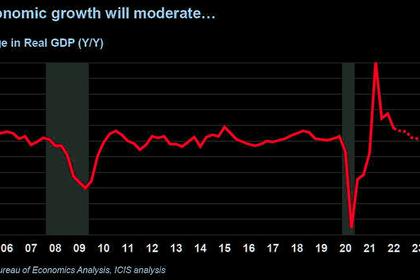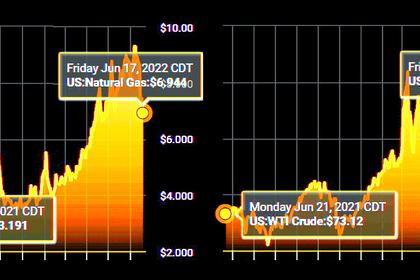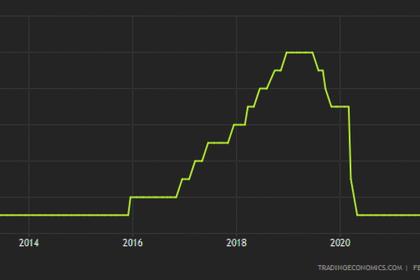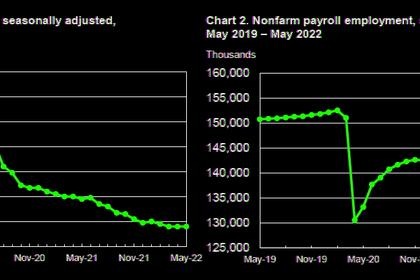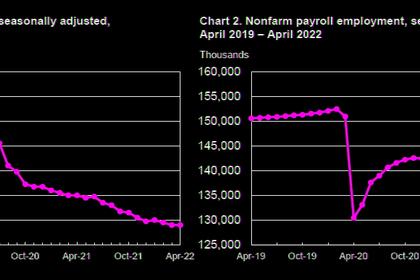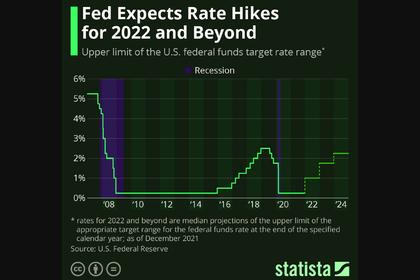
U.S. EMPLOYMENT UP BY 372,000
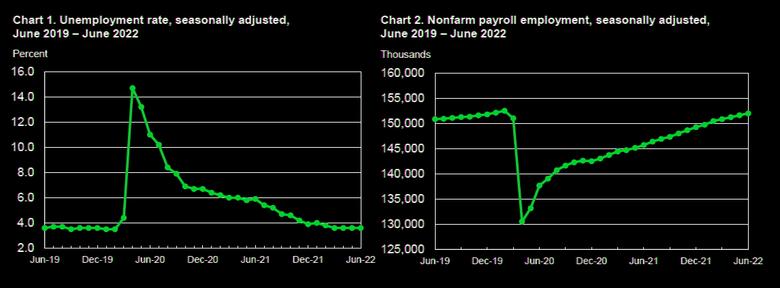
U.S. BLS - July 8, 2022, - THE EMPLOYMENT SITUATION—JUNE 2022
Total nonfarm payroll employment rose by 372,000 in June, and the unemployment rate remained at 3.6 percent, the U.S. Bureau of Labor Statistics reported today. Notable job gains occurred in professional and business services, leisure and hospitality, and health care.
This news release presents statistics from two monthly surveys. The household survey measures labor force status, including unemployment, by demographic characteristics. The establishment survey measures nonfarm employment, hours, and earnings by industry. For more information about the concepts and statistical methodology used in these two surveys, see the Technical Note.
Household Survey Data
The unemployment rate was 3.6 percent for the fourth month in a row, and the number of unemployed persons was essentially unchanged at 5.9 million in June. These measures are little different from their values in February 2020 (3.5 percent and 5.7 million, respectively), prior to the coronavirus (COVID-19) pandemic. (See table A-1.)
Among the major worker groups, the unemployment rate for Asians increased to 3.0 percent in June. The jobless rates for adult men (3.3 percent), adult women (3.3 percent), teenagers (11.0 percent), Whites (3.3 percent), Blacks (5.8 percent), and Hispanics (4.3 percent) showed little or no change over the month. (See tables A-1, A-2, and A-3.)
Among the unemployed, both the number of permanent job losers, at 1.3 million in June, and the number of persons on temporary layoff, at 827,000, changed little over the month. These measures are little different from their values in February 2020. (See table A-11.)
In June, the number of long-term unemployed (those jobless for 27 weeks or more) was essentially unchanged at 1.3 million. This measure is 215,000 higher than in February 2020. The long-term unemployed accounted for 22.6 percent of all unemployed persons in June. (See table A-12.)
The labor force participation rate, at 62.2 percent, and the employment-population ratio, at 59.9 percent, were little changed over the month. Both measures remain below their February 2020 values (63.4 percent and 61.2 percent, respectively). (See table A-1.)
The number of persons employed part time for economic reasons declined by 707,000 to 3.6 million in June and is below its February 2020 level of 4.4 million. These individuals, who would have preferred full-time employment, were working part time because their hours had been reduced or they were unable to find full-time jobs. (See table A-8.)
The number of persons not in the labor force who currently want a job was essentially unchanged at 5.7 million in June. This measure is above its February 2020 level of 5.0 million. These individuals were not counted as unemployed because they were not actively looking for work during the 4 weeks preceding the survey or were unavailable to take a job. (See table A-1.)
Among those not in the labor force who wanted a job, the number of persons marginally attached to the labor force, at 1.5 million, was essentially unchanged in June. These individuals wanted and were available for work and had looked for a job sometime in the prior 12 months but had not looked for work in the 4 weeks preceding the survey. Discouraged workers, a subset of the marginally attached who believed that no jobs were available for them, numbered 364,000 in June, little changed from the prior month. (See Summary table A.)
Household Survey Supplemental Data
In June, 7.1 percent of employed persons teleworked because of the coronavirus pandemic, down from 7.4 percent in the prior month. These data refer to employed persons who teleworked or worked at home for pay at some point in the 4 weeks preceding the survey specifically because of the pandemic.
In June, 2.1 million persons reported that they had been unable to work because their employer closed or lost business due to the pandemic—that is, they did not work at all or worked fewer hours at some point in the 4 weeks preceding the survey due to the pandemic. This measure is up from 1.8 million in the previous month. Among those who reported in June that they were unable to work because of pandemic-related closures or lost business, 24.8 percent received at least some pay from their employer for the hours not worked, little different from the previous month.
Among those not in the labor force in June, 610,000 persons were prevented from looking for work due to the pandemic, up from 455,000 in the prior month. (To be counted as unemployed, by definition, individuals must be either actively looking for work or on temporary layoff.)
These supplemental data come from questions added to the household survey beginning in May 2020 to help gauge the effects of the pandemic on the labor market. The data are not seasonally adjusted. Tables with estimates from the supplemental questions for all months are available online at www.bls.gov/cps/effects-of-the-coronavirus-covid-19-pandemic.htm.
Establishment Survey Data
Total nonfarm payroll employment rose by 372,000 in June, in line with the average monthly gain over the prior 3 months (+383,000). In June, notable job growth occurred in professional and business services, leisure and hospitality, and health care. (See table B-1.)
Total nonfarm employment is down by 524,000, or 0.3 percent, from its pre-pandemic level in February 2020. Private-sector employment has recovered the net job losses due to the pandemic and is 140,000 higher than in February 2020, while government employment is 664,000 lower.
Employment in professional and business services continued to grow, with an increase of 74,000 in June. Within the industry, job growth occurred in management of companies and enterprises (+12,000), computer systems design and related services (+10,000), office administrative services (+8,000), and scientific research and development services (+6,000). Employment in professional and business services is 880,000 higher than in February 2020.
In June, leisure and hospitality added 67,000 jobs, as growth continued in food services and drinking places (+41,000). However, employment in leisure and hospitality is down by 1.3 million, or 7.8 percent, since February 2020.
Employment in health care rose by 57,000 in June, including gains in ambulatory health care services (+28,000), hospitals (+21,000), and nursing and residential care facilities (+8,000). Employment in health care overall is below its February 2020 level by 176,000, or 1.1 percent.
In June, transportation and warehousing added 36,000 jobs. Employment rose in warehousing and storage (+18,000) and air transportation (+8,000). Employment in transportation and warehousing is 759,000 above its February 2020 level.
Employment in manufacturing increased by 29,000 in June and has returned to its February 2020 level. Information added 25,000 jobs in June, including a gain of 9,000 jobs in publishing industries, except Internet. Employment in information is 105,000 higher than in February 2020.
In June, employment in social assistance rose by 21,000. Employment continued to trend up in child day care services (+11,000) and in individual and family services (+10,000). Employment in social assistance is down by 87,000, or 2.0 percent, since February 2020.
Wholesale trade added 16,000 jobs in June, including 8,000 in nondurable goods. Employment in wholesale trade is down by 18,000, or 0.3 percent, since February 2020.
Mining employment rose by 5,000 in June, with a gain in oil and gas extraction (+2,000). Mining employment is 86,000 above a recent low in February 2021.
Employment showed little change over the month in other major industries, including construction, retail trade, financial activities, other services, and government.
In June, average hourly earnings for all employees on private nonfarm payrolls rose by 10 cents, or 0.3 percent, to $32.08. Over the past 12 months, average hourly earnings have increased by 5.1 percent.
In June, average hourly earnings of private-sector production and nonsupervisory employees rose by 13 cents, or 0.5 percent, to $27.45. (See tables B-3 and B-8.)
The average workweek for all employees on private nonfarm payrolls held at 34.5 hours in June. In manufacturing, the average workweek for all employees was little changed at 40.3 hours, and overtime fell by 0.1 hour to 3.2 hours. The average workweek for production and nonsupervisory employees on private nonfarm payrolls remained at 34.0 hours. (See tables B-2 and B-7.)
The change in total nonfarm payroll employment for April was revised down by 68,000, from +436,000 to +368,000, and the change for May was revised down by 6,000, from +390,000 to +384,000. With these revisions, employment in April and May combined is 74,000 lower than previously reported.
(Monthly revisions result from additional reports received from businesses and government agencies since the last published estimates and from the recalculation of seasonal factors.)
-----
Earlier:
